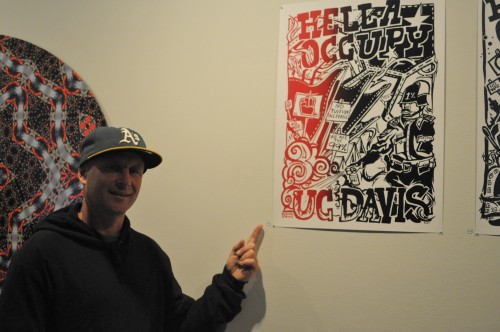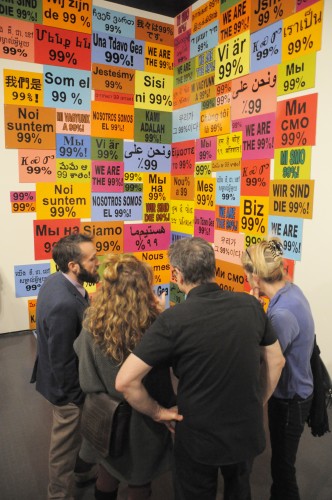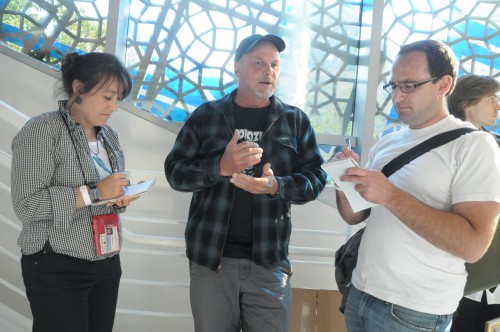
Artist Jon-Paul Bail shows his Hella Occupy poster at the Occupy Bay Area art show on July 14, 2012 at the Yerba Buena Center for the Arts in San Francisco. Photo by Shane Menez
By C. B. S. Lee
July 25, 2012
In “Occupy Bay Area,” the Yerba Buena Center for the Arts celebrates the social justice activism in the arts which has thrived in the Bay Area from the 1960s to the Occupy Movement.
The curators found and paired historical street art and photojournalism from the 1960s and 1970s with Occupy posters and video from 2011 and 2012. The opening night on a recent Saturday hummed with energetic discussions around the shared themes of income inequality, public education spending, free speech and the influence of money in elections.
“There’s a large community of artists and graphic designers committed to social justice in the Bay Area, and they have created amazing imagery in support of the values of the Occupy Movement,” says Betti-Sue Hertz, director of visual arts at YBCA, on the “Occupy Bay Area” website.
The evening was punctuated with proclamations of “mic check” – an Occupy-style verbal call-and-response method for making announcements. When the group responds to “mic check?” with a answering “mic check!” then a group discussion or announcement begins.
The mic check opens the “human microphone” in which the audience members in the first row repeat the speaker’s words to those in the second, and so on, until the message gets to the back of the room. The YBCA two-level atrium was filled with voices more than once for these high-volume discussions, forcing the live music to stop.
A shower of color snapshots fluttered from the balcony when one Occupier shared the street photography of artist Kelly Johnson as a gift. A speaker drew cheers with, “We recognize that artists are cultural workers in the movement,” and another with, “Artists should not have to work for free.”
Event participants pointed out favorite pieces to companions, took pictures in front of the posters and posed with a giant-headed costumed Buddha Occupier, who carried a sign reading “Occupy your heart.”
Occupy Links to Bay Area History
The rock poster artist Chuck Sperry said he was channeling the rock posters of the 1960s when he designed his radiant, “This Is Our City…General Strike.”
He gave away hundreds of copies of his large format double-sided print at the November 2 General Strike in Oakland in 2011. “I wanted to combat the negative view of Occupy that was happening. I just thought it would look great to have hundreds of people waving bright, sunny posters,” Sperry said.

Attendees check out artwork on display at the Occupy Bay Area art show on July 14, 2012 at Yerba Buena Center for the Arts in San Francisco. Photo by Shane Menez
Many of Sperry’s rock posters have become collector’s items with limited print runs for popular bands such as the Black Keys and Soundgarden. When collectors ask how to get one of his Occupy posters, he cheerfully invites them to pick one up for free at a demonstration.
For the opening night, he brought a large sheaf of posters and set them out to be liberated. Many guests left with a rolled-up Sperry poster tucked under their arms on the way out the door.
The exhibit connects some key historical Bay Area movements and their street art to the present Occupy posters by hanging the posters on the same wall which creates a continuum of political art through the decades. The heavy black ink outlines in the 1960s Black Panther posters by Emory Douglas have a high contrast effect, much like the nearby duo-tone posters printed in 2011-12 by Jon-Paul Bail, who prints under the name of Political Gridlock.
Bail, admiring a grouping of three Douglas posters, said his generation of political poster artists had learned much from Douglas and his activist peers.
“They showed us how to be part of the community and now we’re raising our own kids, teaching them the same responsibility to community,” Bail said.
Photographer Ilka Hartmann’s black and white photos in a different room depict the connection between the American Indian Occupation of Alcatraz, Bay Area social justice activism and the Occupy movement.
In November 1969 an initial group of 92 American Indians occupied Alcatraz Island. More people joined the island population during the 19-month occupation, until June 1971 when federal marshals removed the small group of remaining activists.
Hartmann said that even though the American Indians didn’t gain title to Alcatraz, their occupation “inspired many people in the Bay Area and Europe to find out the history of the Native Americans.”
Hidden communities of American Indians were galvanized to become leaders and educators, she said, and even “President Nixon had a consciousness-raising that reversed Federal policy to eliminate tribal areas and gave back land.”
Alcatraz Occupier Adam Fortunate Eagle spoke to the Occupy movement in 2011 in Novato, where he currently lives, Hartmann said.

Fog City Journal reporters Catherine Lee and Brian Rinker talk to artist Chuck Sperry (center) on July 14, 2012 at the Occupy Bay Area art show at Yerba Buena Center for the Arts in San Francisco. Photo by Shane Menez
Small Exhibit is Just a Sampling
The exhibit aims to pay “special tribute to the role that Bay Area artists have played in giving voice to the 99% and utilizing art as an effective vehicle for social change,” according to the YBCA exhibition text.
The real value of the exhibit is in gathering posters from assorted collections, eras and struggles into one gallery. Out in the Bay Area there are more works to be found: printed and inked, pasted on walls, and shared in the public areas like the plywood walls on construction sites. The YBCA show is a good introduction to finding more activist art and poster history in the living gallery of the streets.
“Occupy Bay Area” is showing until October 14. The galleries are free the first Tuesday of each month from noon to 8 p.m.


 The Hunger Site
The Hunger Site
February 23, 2015 at 3:28 pm
This article is a perfect metaphor for the shallowness of the exhibit itself. I had not read it fully till now. My friend Debrah (moma) and i were not part of the exhibit as we mic checked and “showered photos” as “gifts”. we were protesting the shallowness of the artistic representation of occupy. the mic check that was staged by the gallery was then interrupted by Deb and myself, Kelly Johnson, “street Photographer”, we were both actual occupiers and activists and were very offended by the display noting that there was no actual, san francisco occupiers there. The images that i gifted to the attendants were meant to show the actual faces and participants of OSF. since they were nowhere to be seen at this particular show.
July 28, 2012 at 5:35 pm
Movie
https://vimeo.com/33854206